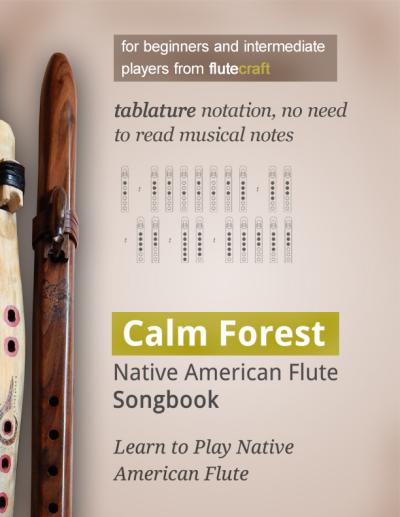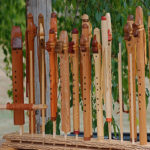Playing the Native American style flute is not difficult. With few minutes of practice, you can already make simple melodies. Within an hour you can memorize a couple of songs, and after few weeks of regular practice you can play nicely your own songs. But before you do so, some fundamental and basic elements should be learned. Learning how to play the flute is possible with on-line resources. A face-to-face teacher is a great idea, but if you cannot find one (like I couldn’t do so), the Internet is your friend.
In this article you will learn how to form an embouchure, how to blow into the flute, and how to make the sound. Then, you will learn how to play the scale and form basic melodies. And finally, you will learn how to read the simplest tablature for Native American flute music.
Make the First Sound
An obvious thing to do when you wish to learn how to play the flute is to make the first sound. This requires learning how to form an embouchure with your mouth and how you breathe in the air into the mouthpiece, and of course, how to actually hold the flute. Before you do so, there are few things you need to learn.
- First, if you’re a total beginner, the best way to hold the flute is the one that feels comfortable and allows you to seal the finger holes nicely. So just get comfortable.
- With time, you will notice that different flutes requires a different way to hold them. Small flutes are the easiest flutes to play. But the bigger the flute, the bigger the challange. The bigger the flute, the heavier it becomes, so angle at which you hold the flute will change. Sometimes, you may need to hold the big bass flute almost vertically, because large flutes will weaken your muscles after a couple minutes of playing.
- Also, the bigger the flute, the bigger the space between finger holes become. If you have small hands, you may even be unable to play a bass flute. Most people can still hold and play an F#4 flute, but anything bigger than that may prove difficult. Keep this in mind when buying your first flute.
- Notice the angle between your fingers and the rest of the flute – it should not be a 90 degrees angle :). Thus do not place your fingers perpendicular to the flute’s body. Rest them at an angle, say 60 to 50 degrees. This increases your accuracy, the seal of the finger holes, and the speed of your fingers. It becomes quite useful when you wish to learn flute decorations and articulations.
Take the flute into both your hands and place it in front of you at a general 45 angle, the end of the flute facing the ground – the bigger the flute, the more vertical your hold becomes. Notice – the fingers 2, 3 and 4 of both hands are used to cover the finger holes – the little fingers, but mainly the thumbs are used to support the flute. Make sure your back is straight, and that your diaphragm is free to operate. This will support your breathing.
Now lean the flute’s mouthpiece on your lower lip, and cover the mouthpiece with your upper lift while not putting the mouthpiece into your mouth – this will form an embouchure with your mouth. And this may take a bit of practice… or not :). It depends on the flute – different flutes have different shapes of mouthpieces. Generally, what you want to do is the above, more or less – enclose the mouthpiece with your lips while not placing the flute in your mouth.
This way, you will get better control over the flow of the air and its pressure, and you will limit the amount of moisture getting into the flute.
The next step is to cover all the finger holes – depending on your flute, there may be five or six of them. Cover the finger holes with your flat fingers, and not with the tips of your fingers. Flat fingers provide a much better seal on the finger holes. If the seal is not complete, the flute will make a squeaky sound. Always make sure you seal the holes properly.
Now, blow the air into the flute. Do this gently at first, and start increasing the strength and pressure of the air flow bit by bit. As you do so, you will notice the sound getting from weak to loud, from “unsure” to steady. And in case of some flutes, you may even notice an overblow, when the tone of the flute’s sound goes up significantly.
Notice the pressure you need to apply in order for your flute to produce a steady and clear sound. When all the finger holes are closed, the sound the flute makes is called “the fundamental” – it’s the flute’s fundamental tone, or “Key”. There are different Keys – it’s a term originating in the European music theory. Popular keys of the flute are A, G and F#, but don’t worry about that. You should already know the Key of your own flute, it’s usually marked on the flute, or written down in the flute’s chart or the documentation of your flute.
Learn the Basic Pentatonic Scale
Now you know how to make a sound with your flute. Soon you may wish to learn how to create and play simple melodies – to do so, you need to learn the scale of the flute – what it is and how to play it.

The basic pentatonic scale – Nakai notation and finger tablature.
The above illustration shows a typical six-holes flute. At the very top is a symbolic mouthpiece and there are six holes below. The black dots are the closed holes, and the white holes are the open holes. The third hole from the top is often present in flutes – but some flutes do not have it, it depends on the flute’s maker. That is why it is shown on the illustration above as a constantly closed hole – in the basic pentatonic scale, it plays no role at all. So keep it closed all the time for now. The way of showing what holes are open and closed on similar illustrations is a typical tablature for the Native American flute – often, such tablature is called “the fingering chart” – because it shows you which fingers should be used to play which note :).
A Native American flute can play multiple scales – but for now, do not worry about it, focus on the basics first, and later on you will be able to expand your knowledge.
You can play the pentatonic scale up by opening the finger holes one by one like on the image above. Just lift the finger up. You can reverse the process and close the holes one by one to play the scale backwards.
Flutopedia, a great website about Native flutes, can provide you with samples of many different NAF flutes playing the scale – Keys on Flutopedia
Below the tablature (fingering chart), you can see a classic staff – with the four #### symbols – the sharp symbols. In case of the Native American style flute they suggest we’re dealing with the Nakai notation. This way of writing NAF music on the staff has been developed by Carlos R. Nakai. With the illustration above, and a bit of practice, you can learn how to read staff music for the NAF :).
The Nakai notation is very useful, because the songs written with this notation can be played by every Native American style flute – the lowest note on the staff always represents the lowest possible note on the flute – the fundamental, or Key, note.
As you progress from the lowest note to the highest note, you may notice that the higher the note, the weaker it sounds if you maintain the same air pressure. This is because the higher the note, the more air it requires to remain a steady note. Thus, as you move up the scale, you need to increase the air pressure, and as you move down the scale, you need to decrease the air pressure. In other words – high notes need more air, low notes need less air. The changes of the air pressure need a bit of practice and they will be different for each flute – you learn by playing and gaining experience.
Something similar can be noticed in flutes in general – the large, bass flutes require little air to make a clear sound. The short, small and high sounding flutes require a lot of air to make a clear sound. And the minor flutes meet up in the middle :).
Two Basic Exercises for Playing the Scale
Now that you know how to make a sound and how to play the scale, you can practice some basic exercises. Let’s start with learning the basic tablature. Look at the illustration below.

Pentatonic Scale – Tablature Exercise
Use it to practice the basic pentatonic scale. Just play up and down the scale as many times as you like – the goal is to get better :). Start slowly first, and then increase the speed a little, and then a little more. Continue to play this for at least 5 to 10 minutes.
The next step is to memorize the Nakai staff notation – in other words, you learn how to read music! You should really learn how to read music notation, because a lot of songs can be played on the NAF, but at the same time, a lot of these songs is written on a staff without the tablature. And in reality, learning to read the basic Nakai notation is very simple!
For now, just look at the first illustration of the scale, the one showing the fingering chart (tablature) along with the corresponding notes on the staff, and try to memorize the way each note on the staff is played by looking at the respective fingering above the note. Then, take the flute and start playing – look at the note and play it, then move to the next note and play it. Do so until you have played the whole scale up and down.

Pentatonic Scale – Nakai Notation Exercise
Then, play the scale from the staff again, this time trying to avoid looking at the respective tablature. But if you forget how a specific note is played, well, then just take a quick look at the tablature – the fingering chart, and play the note. In reality it’s all about memorizing – you create new connection between the neurons in your brain. After a bit of practice – from 15 to 40 minutes or so, you should be able to play the whole scale without the tablature, just by looking at the staff. When you do, take a break.
On the next day, repeat the staff exercise. You may notice that once again you have to support yourself with the tablature, because some things got forgotten. It’s normal in most cases – just repeat the whole exercises and take another break. The next day, repeat it, and repeat it on the fourth day, as well – take as much time as you need. By repeating this exercise, the connections in your brain are formed for good – after a couple of hours of practice in total, you will memorize how to play the notes for the rest of your life. This is how humans learn things :).
Summary
This article, hopefully, helped you learn how to make a sound with your flute, how to play the scale, and how to play the notes written in Nakai notation. All these simple things are the basics for playing the Native American style flute. They’re a good foundation that will support the next lessons and exercises.
Featured photo – http://en.wikipedia.org/wiki/Native_American_flute#/media/File:Native_American_Flute_Busker_by_David_Shankbone.jpg
Don't forget to become a fan on Facebook and subscribe to new posts via RSS or via email.









 via EMAIL
via EMAIL